Jewish Folktales and Talmudic Stories For Children (Page 1) |
If you wish to purchase any of these books, click on either the title or the book cover to be directed to Amazon.com. As a warning, I have put up pictures of the book covers to give you somewhat an idea of the style of each book (I know, I know. "Don't judge a book by its cover") so the pages may load slowly, depending on the speed of your internet connection.
If this page came up without frames, Click here to see the complete website
Other Pages of Interest:
Jewish Folktales and Talmudic Stories for Children
(Page 1)
(Page 2)
(Page 3)
(Page 4)
(Page 5)
(Page 6)
(Page 7)
Easy Reader and Picture Books:
Jewish Children's Books (General) |
Jewish Board Books |
Biblical Stories for Children |
Jewish Holiday Books |
Jewish Family Cookbooks |
Jewish Folktales and Talmudic Stories for Children
(Page 1)
(Page 2)
(Page 3)
(Page 4)
(Page 5)
(Page 6)
(Page 7)
|
Jewish Life Books (Mitzvot, Keeping Kosher, etc.) |
Jewish Life Cycle Books |
Family Haggadahs |
Children's Prayerbooks |
Introductory Hebrew Books |
Jewish History and Historical Fiction Picture Books |
Israel Books
Middle School and YA Books:
Bar Mitzvah Books |
Jewish Fiction |
Historical Fiction |
Torah Study |
Prayer and Jewish Life Books |
Jewish Holidays |
Jewish Biographies |
Jewish History Books |
Holocaust Books for Teens |
Israel Books
Jewish Books for Children |
Bar Mitzvah Books |
Jewish Parenting Books |
Jewish Music for Children |
Jewish Videos |
Jewish Toys and Gifts |
Jewish Gift Baskets and Gourmet Food |
Jewish Jewelry |
Amazon.com Coupons, Promotions, and Sales
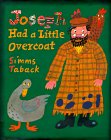
Joseph Had a Little Overcoat
By Simms Taback
Awards:
2000 Caldecott Medal winner
When Joseph's favorite overcoat gets old and worn, he makes a
jacket out of it. When the jacket is more patches than jacket,
Joseph turns it into a vest. When the vest's number is up,
Joseph makes a scarf. This thrifty industry continues until
there's nothing left of the original garment. But clever
Joseph manages to make something out of nothing! (And
that's the foreshadowed moral of the story.)
In today's throwaway world, Joseph's old-fashioned frugality
is a welcome change. Based on a Yiddish song from Simms Taback's
youth (lyrics and music reproduced on the last page), the
book is filled with rhythms and arresting colors that will
delight every reader. As more and more holes appear in
Joseph's coat, die-cut holes appear on the pages, hinting
at each next manifestation. The illustrations are striking,
created with gouache, watercolor, collage, pencil, and ink.
Every inch of space is crammed with fanciful, funny details,
such as the headline on a discarded newspaper: "Fiddler on
Roof Falls off Roof."
Description from Amazon.com
This Caldecott Award-winning book features playful illustrations and a witty text to retell the classic tale of a tailor who can always make something out of nothing. Joseph once had an overcoat which became old and worn, so he makes it into a jacket. When the jacket becomes work, Joseph turns it into a vest. This continues until he is left with only a button. When the button gets lost, Joseph can still manage to create something. Each page of the book features a cutout to help children visualize the overcoat becoming the new article of clothing. Adults will love the witty sayings scattered throughout the illustrations ("Fiddler on Roof Falls off Roof" in the newspaper and "Chad Gadya" on a bedroom poster). Adults and children alike will be enchanted by the detailed combination of drawings and photographs on each page. A superb choice for preschool and elementary school readers.
Lori's Description
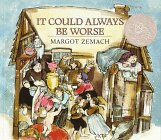
It Could Always Be Worse :
A Yiddish Folk Tale
By Margot Zemach
"Noise, arguing -- the close quarters problems of a large extended
family -- finally become too much for the 'poor, unfortunate' father. He
goes to the Rabbi, who advises him to bring the barnyard animals into the
one-room, overcrowded house -- with predictably hectic and hilarious
results . . . A natural for story hour."
Starred Review from School Library Journal
Margot retells a classic Yiddish folktale in this charming picture book. A poor man lives in a small house with his wife, mother, and six children. Life is obviously quite chaotic for the residents of these close quarters. When the man complains to his Rabbi, he is told to bring the barnyard animals into the house one by one. Craziness ensues, until the Rabbi instructs the poor man to put all the animals back into the barn. After that, the family can savor the newfound peace and quiet. Hilarious watercolor paintings add to the increased craziness inside the small house. Children will delight in the narrative about the hectic nature inside the house.
Lori's Description
Awards:
A Caldecott Honor Book
ALA Notable Book Fanfare
The Horn Book's Honor List
A New York Times Book Review
Notable Children's Book of the Year
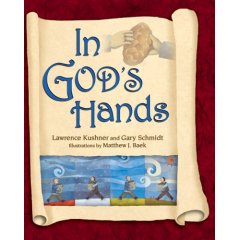
In God's Hands
By Lawrence Kushner and Gary D. Schmidt
When the sun sets and stars fill the sky, the square in the little town grows quiet and still. The cool air of distant hills mingles with the sweet scent of baking bread. The moon rises and glows softly. It’s the sort of place where miracles could happen.
David and Jacob live in the same little, ordinary town, but it’s almost as if they’re from different worlds. David is so poor he can barely feed his family. Jacob is so consumed with staying rich he thinks about nothing but money. But the two men have one thing in common: they both believe that miracles are big, magical things that can only happen somewhere else, to someone else. But when Jacob wakes up from a nap in synagogue one day, sure that God has demanded twelve loaves of bread from him, all this changes in amazing ways you’d never expect. A delightful, timeless legend based on Jewish tradition, In God’s Hands tells of the ordinary miracles that occur when we really, truly open our eyes to the world around us.
Description from Publisher
This superb book demonstrates how God's miracles can often come about through people's actions. Jacob is a rich man who lives in the same town as poor David. Jacob falls asleep during the Torah reading one day, but wakes up just in time to hear the verse from Leviticus, "You shall bake twelve loaves of challah, and set them before Me in two rows, six in each row". Jacob assumes that God was speaking directly to him and, while he thinks the request is a bit unusual, who is he to question God's request? He promptly goes home and bakes twelve loaves of challah and places them in the synagogue's ark. Soon afterwards, David prays to God for some food to feed his family and then opens the ark. When he sees the twelve loaves of challah, he assumes that God has answered his prayers and takes the challah loaves home to his family. When Jacob sees that the challah loaves are all gone, he believes that God ate the challah and decides to continue making challah loaves each week. This continues for several years (Jacob bringing challah to the ark, David taking the challah home, neither man knowing that the other one is involved) until a wise Rabbi teaches the two men that their hands are God's hands. Kushner and Schmidt have created an excellent storybook to clearly demonstrate an important lesson, without being preachy. The narrative style is perfect for reading aloud. Baek's warm illustrations effectively evoke the character's varying emotions. An excellent choice for preschoolers and elementary-aged students.
Lori's Description

Something from Nothing
By Phoebe Gilman
In this lively adaptation of a folk tale, Gilman creates a close-knit Jewish
community in which nothing goes to waste. The wonderful baby blanket
Grandpa made for Joseph has begun to wear out. When Grandpa takes a
look at it, he finds "just enough material here to make . . ." something smaller.
First, he makes a jacket. When that wears out, he makes a vest, then a tie, and
so on. Finally, there is only enough fabric remaining to cover a button. When
Joseph loses his button, he is heartbroken until he realizes that there is "just
enough material here to make . . ." one more thing--a good story. Framed by
borders that look like wooden beams, busy street scenes and cutaway interiors
offer lots of old-world atmosphere. The borders also set off a complementary
picture story about a mouse family living beneath the floor of Grandpa's home.
Children will readily follow the tiny creatures' escapades and appreciate their
ingenuity in turning scraps from Joseph's blanket to their own advantage. The
red-gold tones of the background and the rich browns in the artwork lend a
feeling of warmth that perfectly replicates the flavor of the sweet, funny tale.
Description from Booklist
This delightful adaptation about a resourceful grandfather is based on a Yiddish folk tale. Joseph receives a blue blanket from his grandfather as a baby gift. After years of use, the blanket becomes worn and tattered. Instead of throwing the blanket out, Joseph gives it back to his grandfather, who transforms it into a jacket. When the jacket gets too small, his grandfather turns it into a vest. This continues over and over again, until Joseph's grandfather turns the fabric into a button. When Joseph accidentally loses the button, he wonders, how will he be able to create something from nothing. This charming tale features enough repetition that children will eagerly read along and try to predict what Joseph's grandfather will create next. The warm illustrations feature details of the activity in each room of Joseph's house. They even include the happenings of a mouse family that inherits whatever scraps are left after Joseph's grandfather has worked his magic. This storybook is sure to be a hit for reading aloud together.
Lori's Description
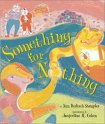
Something for Nothing
By Ann Redisch Stampler
In this Jewish folktale, a dog outsmarts three cats that harass and attempt to terrorize him when he moves into a new house in the country. Finally, Dog offers them gold in exchange for making as much noise as he heard in Bialystok. The cats eagerly accept his challenge, but after three nights they are left exhausted and greedier than ever. The dog asks that they come back and make more noise, even though he can no longer afford to pay them. Refusing to give him "something for nothing," the cats "never disturbed the peace and quiet of Dog's country cottage ever again." The bold, vibrant watercolors, many of them spreads and full-page illustrations with lots of pink, orange, green, and purple hues, are wonderfully evocative and detailed. In an author's note, Stampler explains that although she has found oral remembrances of this tale, she has not located other written versions. An appealing story that would make a fine read-aloud with lots of sound effects.
Description from School Library Journal
When Dog can no longer endure the clatter and clanging and rumbling and banging of the marketplace in Bialystok, he sets off for the country to find a quieter place to live. But on his first night in his new home, he is awakened by a gang of howling and yowling, hissing and screeching cats, who bombard his tidy cottage with apples and stones. So much for his newfound peace and quiet!
But clever Dog comes up with a plan ... a very noisy plan. How he outwits his rowdy foes makes for a humorous, satisfying story, exuberantly illustrated with fantastical paintings reminiscent of the work of Marc Chagall.
Description from Publisher
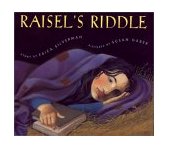
Raisel's Riddle
By Erica Silverman
A lovely re-imagining of the Cinderella story, with a fine twist. Raisel lives in a tiny village
in Poland with her grandfather, a poor scholar. When Zaydeh dies, Raisel goes to town to
seek work and finds it in the kitchen of a famed rabbi. But the cook mistreats her and
keeps her from the Purim party. That night, when Raisel gives her supper to an old woman,
the beggar grants her three wishes. Raisel, who then goes to the Purim party costumed as
Queen Esther and enchants the rabbi's son with her riddle, is wise enough to keep one wish
back and uses it for cleaning the kitchen when she returns at midnight. The next day the
rabbi's son searches for her, and Raisel, locked in the pantry, calls out her riddle: "What's
more precious than rubies, more lasting than gold? / What can never be traded, stolen, or
sold? / What comes with great effort and takes time, but then--/ Once yours, will serve you
again and again?" The rabbi's son knows the answer, which is "learning," and so they "lived
and learned happily ever after." The illustrations in velvety, muted colors make use of strong
geometric shapes and varying perspectives: we see Raisel and her Zaydeh through a window
studying together; the nasty cook looming over Raisel in the rabbi's kitchen; and dramatic
close-ups of Raisel and the beggar woman and a gorgeous one of Raisel dressed as Queen
Esther with the rabbi's son. This universal story fits into its Jewish milieu as neatly as a key in a lock.
Description from Booklist
Silverman tells of Raisel, an orphan girl who is raised by her scholarly grandfather until his death;
three wishes from an old beggar woman allow Raisel to attend the Purim play dressed as Queen
Esther, where she captures the attention of the rabbi's son. It is her clever riddle about the precious
nature of learning, however, that eventually wins his heart. Carefully crafted, this story not only
entertains, but it teaches readers about the Jewish holiday, Purim, Queen Esther, and the tradition
of costumed re-enactment. Unlike a majority of the other versions of the Cinderella story, this one
does not include a self-absorbed prince who combs the countryside looking for a bride of a particular
shoe size; refreshingly, Silverman's hero is as intelligent as he is handsome, and seeks a bride who
is his equal. Graber's illustrations are the perfectly complement, embodying Raisel's transformation
from a life of servitude to one of riches ``more precious than rubies.''
Description from Kirkus Reviews
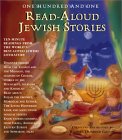
One -Hundred-and-One Read-Aloud Jewish Stories
By Barbara Diamond Goldin (Editor)
Jewish tales, Bible stories, legends and historic accounts from every generation and every land come to life in this captivating collection of short selections designed to introduce pre-readers to the glories of Jewish storytelling.
Reading aloud is the very best way to introduce young children to new worlds, real and imaginary-and to the great pleasures found between the covers of books. This wide-ranging and engaging collection will introduce young and old alike to Biblical heroes, magical and mythical characters, kings, prophets, historic figures and real-life adventurers from Israel, America and many other lands.
Selected and retold by well-known children's author Barbara Diamond Goldin, the stories are designed to be read in ten minutes or less, and the strength and richness of the narratives make them ideal at bedtime. From the stories of Moses, Solomon and Jonah to the legends of the Golem of Prague and the hapless inhabitants of Chelm, and including selections from such renowned writers as Sholom Aleichem and Isaac B. Singer, this is sure to become a treasured volume, read, reread, passed down and loved for years to come.
Description from Piblisher

Stories for Children
By Isaac Bashevis Singer
Thirty-six stories by the Nobel Prize winner, including some of his most
famous such as "Zlateh the Goat," "Mazel and Shlimazel," and "The Fools
of Chelm and the Stupid Carp."
Description from Publisher
In every tale, Singer's cautionary tone takes him from the grade school
shelf and places him in the long line of moral fabulists from Aesop and La
Fontaine to Kafka and Italo Calvino. All the time, it now appears, the
rabbi's son has really been preaching to the adult in every boy and girl.
Description from TIME

A Thousand and One Chickens
By Seymour Rossel
Join the adventures of the befuddled royal family of Chelm as they
seek the help of the kingdom's three silly sages. Jewish wisdom and
Jewish humor intertwine in this charming story for all ages
Description from Publisher

The Adventures of Hershel of Ostropol
By Eric A. Kimmel
Illustrated by Trina Schart Hyman. Kimmel retells ten stories about Hershel of Ostropol, a Jewish folk hero who lived during the first part of the nineteenth century. A man quick with a humorous saying or jest, Hershel lived by his wits, traveling from town to town in Eastern Europe. Readers may recognize Hershel from two of Kimmel's earlier books, Hershel and the Hanukkah Goblins . The latter - which is also the first story in this collection - tells how an empty-pocketed Hershel tricks a stingy innkeeper into feeding him "until his buttons burst." Money is a perennial problem for Hershel, and nothing pleases him more than acquiring it by outwitting rich, miserly folk. Stopping by the village tavern one afternoon, Hershel finds Count Potocki, who wagers one thousand rubles that Hershel can't tell a story so incredible that the count won't believe it. After many tall tales - including one about bees as big as wolves - all of which the count insists he believes, Hershel tells about meeting the count's mother in Hell, where she was sent for giving birth to "that rascal," the count. At that Count
Potocki roars that Hershel is a liar, and Hershel happily pockets the
money and leaves. Each story is illustrated by humorous
black-and-white drawings. --
From School Library Journal
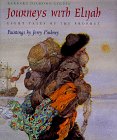
Journeys With Elijah :
Eight Tales of the Prophet
By Barbara Diamond Goldin
This gathering of retold stories from the Talmud and elsewhere features
dazzling watercolor art matched to encounters with the Old Testament
figure who has become, as Goldin
(While
the Candles Burn, etc.)
writes, "a symbol of hope, a figure who stands for what is just and
good in the world." She evokes the worldwide "journey" of the Jewish
people by setting her tales in an array of times and places, from
modern Israel to Argentina and ancient China; no matter where he
puts in an appearance, Elijah offers choices or chancy blessings
that, often indirectly, lead the perplexed, misled, or discontented
to wisdom. From tiny, jewel-like title decorations to crowd scenes
that ripple with movement, Pinkney's watercolors provide a
shimmering backdrop to these reverent, simply told renditions.
From Kirkus Reviews
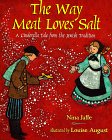
The Way Meat Loves Salt :
A Cinderella Tale from the Jewish Tradition
By Nina Jaffe
The Way Meat Loves Salt: A Cinderella Story from the Jewish Tradition
answers another perennial question that stems from both the Ten Commandments
and human nature: How much can a child love and honor a parent? "I love you as
much as diamonds," the oldest daughter answers her father. "I love you as
much as gold and silver," the second daughter answers. "I love you the way meat
loves salt," the third daughter, Mierleh, replies. Banished from her father's home
for this seemingly disrespectful declaration, Mireleh discovers her own path with
the help of Elijah the Prophet as fairy godmother.
Description from The Jewish Sentinel review - May 14-20, 1999
This Yiddish story combines the stories of Cinderella and King Lear for a wonderful treat! When a rabbi asks his daughters how much they love him, his youngest daughter, Mireleh replies that she love him "the way meat loves salt." He interprets this as an insult and banishes her from his house. Once she reaches the countryside, Mireleh receives help from Elijah the Prophet, who gives her a magic stick that will grant her any wish and tells her to go to the home of a wealthy rabbi. Although the rabbi and his wife allow Mireleh to stay in their attic, they will not allow the beggar girl to join them at a wedding feast. When Mireleh uses her magic stick to conjure up a beautiful dress, she attends the wedding and the wealthy rabbi's son falls madly in love with her. At the feast for her own wedding, Mireleh asks that the food be prepared without any salt. At the feast, a rabbi complains that the food tastes horrible, and Mireleh reveals herself to her father who suddenly understands the love she had expressed so long ago. The oil paintings beautifully capture the flavor of an older time. Children will love the expressive narrative and the variation of the familiar Cinderella story. An excellent choice for reading aloud.
Lori's Description
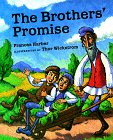
The Brothers' Promise
By Frances Harber
In this traditional Jewish tale, a father dies and leaves his farm to his two sons,
who share the farm and look after each other, despite their very different lifestyles--
Yankle is a happily married family man, and Josef is a loner who spends his time
reading religious books. When a drought threatens the farm, the brothers independently
decide that the other needs whatever food has been saved. In a comic episode, the duo
go back and forth delivering food and wondering why they are each winding up with more
instead of less. Finally, they run into each other and, in a happy moment of realization,
remember their father's words: "When a brother helps a brother, the angels in heaven
weep tears of joy."
from Booklist
In a poignant Talmudic tale of companionship, sharing, and respect, two farmer brothers make a promise to their dying father to help each other through life. If they do, their father tells them, ``the angels will weep with joy.'' Although the brothers are markedly differentmarried Yankel is a bon vivant who enjoys to fiddle and dance, while single Josef prefers to quietly read the holy books at nightthey get along, and are good-natured about their differences. When hard times hit the farm in the form of a dry spell, their loyalty is tested, and each brother sacrifices his own security to make sure the other has food. The brothers are provided for, courtesy of divine intervention, and the angels do weepit rains. Wickstrom's gentle characters bring the simple, lovely sentiment to life in a setting of rolling hills, illuminated by sunlight and candlelight.
Description from Kirkus Reviews
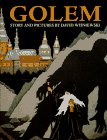
Golem
By David Wisniewski
Awards:
Caldecott Medal 1997
A monumental story of good and evil-and the gray areas in between-receives
a dramatic presentation through Wisniewski's intricately cut colored-paper
collage. The story takes place in sixteenth-century Prague, where Jews are
being attacked mercilessly following the general acceptance of the "Blood
Lie," a rumor that Jews are making their Passover bread from flour, water,
and the blood of Christian children. To protect his people, Rabbi Loew
decides to invoke the Golem, a giant made of clay. After creating the giant,
the rabbi places the word emet , Golem is young and innocent, with a childlike
ability to love and trust. The crisply cut colored-paper illustrations have
been painstakingly created to show both small details and large landscapes.
Description from Horn Book
Some four hundred years ago (according to legend) a revered Jewish teacher
and scholar, Rabbi Loew, shaped a giant man of clay called a "golem" and
brought him to life. The golem's task was to vanquish those who persecuted
the Jews of Prague, and he performed it almost too well. Retold from
traditional sources and accompanied by masterly cutpaper illustrations,
Golem is a dramatic tale of supernatural forces invoked to save an oppressed
people. Golem offers a thought-provoking look at the consequences of
unleashing power beyond human control -- even with the best of intentions.
Both the text and the artwork demonstrate David Wisniewski's excellent
storytelling talents.
Description from Midwest Book Review
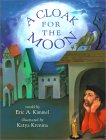
A Cloak for the Moon
By Eric A. Kimmel
Based on a tale attributed to the 18th-century Rabbi Nachman of Bratslav, this luminously rendered story centers on a tailor named Haskel who lives in Tzafat (one of the four holy cities of Israel, long associated with Jewish mysticism). One night Haskel dreams that the moon comes to him, wishing for a cloak to keep herself warm, and Haskel vows to make her one. When he wakes up, he says, "Dream or not, I will keep my promise." Although his uncle, a master tailor, tells him to "stop chasing dreams," Haskel dedicates himself to his goal, and when he hears of a legendary garment that stretches or shrinks to fit the wearer, he sets out to find it, in a journey that takes him first to China and then across the desert to a city evocatively named The Roof of the World. Expertly pacing the story, Kimmel (previously paired with Krenina for The Magic Dreidels) embroiders his prose with graceful details, writing of "radiant satins [and] silks like colored water." The exotic trappings will lure readers, replacing Haskel's determination to keep his promise as the central theme of the work. Intermittently embellished by borders and spot art featuring delicate flower motifs, Krenina's gouache art effectively depicts the Middle and Far Eastern settings of the tale, as well as its timeless sensibility.
Description from Publishers Weekly
Taken from the tales of Rabbi Nachman of Bratslav, this soulful story centers on a tailor, Haskel, who loves to watch the moon and one night dreams that the moon is cold. Vowing to make a cloak of shining material that will cover her as she waxes and wanes, Haskel sets out for China to look for the cloth. Finally, he tracks it to the "roof of the world" and finds a princess who cannot be wed because her wedding dress, made of beams of light, has unraveled. Using his tailor's tools, Haskel discovers that focusing moonlight on the dress with his magnifying glass enables the thread to reweave itself. The princess rejoices, and Haskel is given a bit of the luminous thread as reward. Each night of his return journey, he makes another cloth of light; when he gets home, his dream of a cloak for the moon is fulfilled. Gouache paintings and intricate borders that echo Chinese and Persian design have an exotic richness. Impossible dreams and magical desires fulfilled by dint of persistence and unwavering belief underlie this lovely narrative.
Description from Booklist
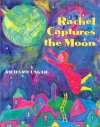
Rachel Captures the Moon
By Richard Ungar
The stories of the fabled village of Chelm and its inhabitants are favorites in Jewish folklore. Newcomer Richard Ungar captures the joyous spirit of these folktales in his words and pictures.
The people of Chelm were crazy about the moon and the way it bathed the village in light. Not content to wait for the moon to rise, some of the villagers decide to capture it so they could see it whenever they wish. First the carpenter tries to reach it with a ladder. The next night the cook tries to entice the moon with soup. The musician, the weaver, and the fisherman all use their arts to try to lure the moon down to the village. To everyone’s surprise, young Rachel succeeds. But how does she capture the moon?
Description from Publisher
Ungar makes an impressive debut in this reworking of a Samuel Tenenbaum story about the profoundly silly people of Chelm. Like Mole in Bringing Down the Moon, the inhabitants of the mythical village are so beguiled by the moon's "wondrous light" that they decide to capture it, "so we will all be able to gaze upon the moon at any time, day or night." Simon the Carpenter tries to build a ladder to it; Selma the Cook, Rafael the Musician and Sarah the Weaver try to tempt the moon down to earth with their respective talents. But only young Rachel is successful to the Chelmites' skewed way of thinking, at least when she captures the moon's reflection in a rain barrel. With dense, jewel-toned watercolors and colored-pencil illustrations, and characterizations and perspectives reminiscent of Chagall and other Jewish visual folklorists, Ungar swiftly and affectionately transports readers to a mythical, long-ago world.
Description from Publishers Weekly
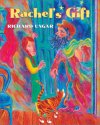
Rachel's Gift
By Richard Ungar
As Passover approaches, Rachel's mother plans to make the best soup in the world to woo Elijah the Prophet and reap a rich reward. Using Bubbie's secret and not very helpful recipe, she begins to cook, and the aroma attracts many visitors with helpful hints of their own. In the end, it is Rachel's gift of kindness to an old man that brings a reward that is more than money. Although this tale lacks the outright silliness of many of the Chelm stories, the "lesson" is accompanied by lively action and smooth prose. The rich watercolor and colored-pencil illustrations in the style of folk art capture the European village setting, and the reds, yellows, and oranges add to the warmth of the tale. A welcome addition to Jewish folklore shelves.
Description from School Library Journal
The author of Rachel Captures the Moon returns to Chelm with this story which combines The Magician with Stone Soup. It is Passover time, and Rachel's mother desperately wants Elijah the Prophet to visit and bestow good fortune on them. She receives a recipe from Bubbie from Bialystock and immediately concludes that she has found her lure. Unfortunately, the recipe is so vague that she must improvise based on what she has in the house. Various members of the community come in and each adds something to the soup to make it even more delicious. After Rachel shows kindness towards a poor visitor, everyone notices that some of the wine in Elijah's cup has disappeared. Rachel's act of generosity was able to teach the adults an important lesson. Ungar's rich Chagall-like watercolors bring a dreamlike quality to the story that will draw children into the story. An excellent addition to a folklore or Passover holiday collection.
Lori's Description
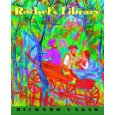
Rachel's Library
By Richard Ungar
The citizens of Chelm have always had a reputation for foolishness. How can they convince people otherwise and show outsiders their true wisdom? Surely the answer lies in the great city of Warsaw. They will send a delegation to the capital to find a solution.
Young Rachel is an unexpected addition to the group, but as always, she is the one with the answer. The clue to wisdom lies in books. What Chelm needs is a library. In her own creative fashion, Rachel finds a way to build a village library – different from any library you can imagine.
Rachel Captures the Moon and Rachel’s Gift have introduced the endearing village of Chelm – always quirky and always full of surprises.
Description from Publisher
Ungar's third story about Rachel, "inspired by" Samuel Tenenbaum's"Chelm's School," finds the clever child traveling to the city of Warsaw with a small delegation of fellow residents who are hoping to find a way to show others that the people of Chelm are wiser than they seem. Rachel's idea to create a library is eagerly accepted, and the townsfolk immediately pool their resources to construct one that, despite its unorthodox design, is both extraordinary and useful to every household. The attractive folk-art illustrations, created with watercolor and thickly applied colored pencil that gives the appearance of oil pastel, are jewel-toned, with heavy use of red, fuchsia, and emerald. They show people in peasant dress, simple cottages, the dirt roads of the shtetl (small 19th-century Eastern European village), and the crowded streets of Warsaw. The humor in this story rooted in Jewish folk literature can be appreciated by children of various backgrounds.
Description from School Library Journal
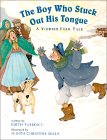
The Boy Who Stuck Out His Tongue :
A Yiddish Folk Tale
By Edith Tarbescu
The widow's son is a naughty boy. When he is asked to help in the house,
he sticks out his tongue and continues throwing snowballs. His mother
retaliates by chasing him. This causes a fall against a wrought-iron
fence. Now the boy's tongue is stuck to the cold metal. What can the
mother do? She goes to the cobbler, the butcher, and the baker. No one
knows what to do about a frozen tongue. Finally, the foolish townspeople
decide to build a hut around the boy to keep him warm until they find a
way to free him. This lighthearted Hungarian story will appeal to young
readers. The boy's predicament is something that still happens to
children in cold weather, particularly on the playground, making this
a good winter tale for the classroom. The illustrations are full of
snowflakes and colorful winter clothing. Each page is bordered with a
brightly patterned, fringed scarf. The story comes from the oral
tradition; the book flap says Tarbescu heard this tale from her
Hungarian father. Yiddish humor, Chelm-like characters, and a tidy
moral inhabit the story without overwhelming it. The story's strongest
feature is the plot, and readers will stay tuned to find out how the
boy's tongue is finally freed.
Description from Children's Literature
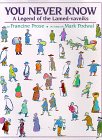
You Never Know :
A Legend of the Lamed-Vavniks
By Francine Prose
While this legend is of Jewish origin, the ideals of righteousness
and equality among human beings (wealthy and poor, learned and
simple) are inherent in many religious and cultural teachings
throughout the world. Poor Schmuel, the town cobbler of Plotchnik,
has a reputation for doing stupid things, which are actually acts
of kindness. When a drought threatens the town, he alone is able
to communicate with God, first bringing rain and then making the
rain cease. The Rabbi eventually realizes that Schmuel is a
Lamed-vavnik, one of the 36 righteous individuals living in the
world who do good deeds. As the legend goes, once their existence
is discovered, they disappear. And so it is with Schmuel.
Prose,
who cites several sources, uses the simple style of the storyteller
to tell this tale, which makes it an excellent read-aloud. By
successfully avoiding a heavy-handed lesson, she allows children
to discover the meaning for themselves. Podwal uses gouache and
colored pencils to create both the smeary look of oils and the
flatness of tempera. His abstract paintings are done primarily
in earthy tones of brown and sky blue, and the pictures are
filled with representations of Jewish symbols. Despite these
images, however, this accessible tale has universal appeal and
will provide enjoyment as well as food for discussion.
Description from School Library Journal
Stories involving secret identities are greatly appealing to
children, and Francine Prose has written a lovely tale around
this intriguing legend.
Description from The New York Times Book Review
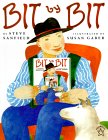
Bit by Bit
By Steve Sanfield
Based on a Yiddish song that Sanfield's grandmother brought with her from
Russia, this is a kind of cumulative story, told with a joyful rhythm and
repetition, and illustrated with bright, clear, large figures that make it great
for group sharing. Zundel the tailor makes himself a coat that he loves:
"He wore it in the morning and he wore it at night. He wore it and wore
it and wore it until bit by bit he / w-o-r-e / it / out." Heartbroken, he
makes what's left of the coat into a jacket, and he loves that even more,
but the jacket wears out. Then he makes a vest, a cap, a pocket, a button,
each one more beloved than the last. The pictures extend the song, showing
the tailor with his loving family through the years, as each piece of clothing
wears out, but his bonds stay strong. The book begins and ends with the
storyteller, which makes clear that the coat does live on as long as the
story is told.
Description from Booklist
Zundel the tailor loves the fabric of his coat so much that he transforms
it into a jacket, then a vest, then a cap, and so on, as each successive
garment wears out. The exuberant illustrations show Zundel interacting with
his growing family. Related by a storytelling narrator, the circular tale is
ideal for reading aloud.
Description from Horn Book

Just Stay Put: A Chelm Story
By Gary Clement
This enjoyable tale tells another tale from the silly town of Chelm. Mendel dreams of travelling, so one day, he decides to head off for Warsaw. When he decides to rest for a bit, he worries that he will forget the way to Warshaw, so he takes off his boots and points them in the direction of Warshaw. After a shepherd moves his shoes, Mendel takes off in the direction his shoes are now pointing: towards Chelm! When he arrives back in Chelm, he is convinced that he is actually in Warsaw. From Mendel's viewpoint, Warshaw looks very familar and surprisingly has a house just like his and a woman inside who very closely resembles his wife. After much deliberation, Mendel decides that since Warsaw and home are so much the same, he may as well just stay put. Gary Clement's pen and ink drawings perfectly balance Mendel's quirky logic. Children will delight in the continuing antics of the residents of Chelm. A perfect choice for reading aloud.
Lori's Description
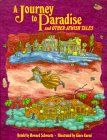
A Journey to Paradise and Other Jewish Tales
By Howard Schwartz
These eight magical tales reflect on the aspirations, mores, problems,
and humor of the Jewish people. Drawn from the Israel Folktale Archives,
the selections come from Eastern Europe, Tunisia, Israel, and Yemen.
"The Flight of the Midwife" demonstrates that in Yemen, the midwife
was noted for her courage, wisdom, and impartiality, even to the extent
of attending to the birth of a female demon in the form of a cat. "A
Student in Magic" has a familiar theme: that one need not travel far
to seek the "prize," as it is usually nearby. The title story
demonstrates the veneration held by Hasidic followers for their rabbis,
even attributing magic powers to them. "An Apple from the Tree of Life"
relates how the Jews strove to please a ruler so that he would leave
them in peace. In "A Messenger from the World to Come," a poor trickster
uses the gullibility of the Chelmites to obtain clothing for his family
by saying that he is from "The World to Come" and that their deceased
loved ones haverequested warm winter clothing. Schwartz is a master
storyteller and Carmi is a proven illustrator, guaranteeing that this
book will be a popular choice for a wide audience.
Description from School Library Journal

Next Year in Jerusalem :
3000 Years of Jewish Stories
By Howard Schwartz
Schwartz, an accomplished folklorist, has collected Jewish folktales,
midrashim, and legends with ties to Jerusalem and presents them here in
a handsomely illustrated book. He begins with a brief history of the
city, both its actual history and the one of legend, from which these
stories come. The tales, which originated in places like Iraq,
Eastern Europe, Spain, and, of course, Israel, cover a wide range. There's
the legend of Serah bat Asher, who lived hundreds of years after being
blessed by Jacob when she told him his son Joseph was alive; there
are tales of King David and his son Solomon, stories of peace,
generosity, and God's love. Sidebars set the tales in a factual
framework, and all are lovingly illustrated by Waldman in a dreamy
style colored with the golds, pinks, and blues that shine from the
real city of Jerusalem.
from Booklist
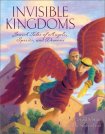
Invisible Kingdoms: Jewish Tales of Angels, Spirits, and Demons
By Howard Schwartz
Come to a world where angels, ghosts, and demons walk amongst the living and anything is possible. Here, in nine tales of the supernatural, invisible creatures take shape and roam the earth to aid or interfere in the lives of humans. A magic staff makes a man see ghosts, a handsome demon tricks a village girl into marriage, and an angel directs a young man through a dangerous venture -- in the guise of a goat!
Howard Schwartz's vibrant retelling of mystical Jewish folktales id full of magic and wonder. The stories span many centuries and range in origin from Middle East to Eastern Europe. Weather you believe in angels, ghosts, and demons os for you to decide, but not before you enter these invisible kingdoms and step into a world where the impossible takes shape and anything can happen!
Description from Publisher

Elijah's Violin & Other Jewish Fairy Tales
By Howard Schwartz
In Elijah's Violin, Howard Schwartz presents a sumptuous collection
of 36 Jewish fairy tales from virtually every corner of the world. These stories
will captivate children and adults alike as they illuminate the Jewish world view,
where faith in God can defeat the evil impulse. "Timeless truth."--Jewish Journal.
Description from Publisher
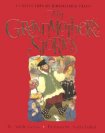
My Grandmother's Stories: A Collection of Jewish Folk Tales
By Adele Geras
More than 30 pages of full-color illustrations bring a Chagall-esque quality to the beautiful compliation of Jewish stories. Readers will be enchanted by each tale as the Grandmother recounts her days as a young girl, cooking and hanging laundry as she plans for the Sabbath, and preparing for the Passover meal. The details of each story emphasize the Jewish traditions and customes that continue in many families today. My Grandmother's Stories is truly the ideal gift for the Jewish holidays -- the lively folk tales and gorgeous illustrations have created an instant classic.
Description from Publisher
Readers can almost smell the strudel Grandma makes in these lovingly evoked, beautifully framed Eastern European Jewish folktales. Each of 10 chapters describes a child's visit to Grandma's, during which a simple act--trying on an aunt's high-heeled shoes, dressing up in a lace tablecloth--inspires a not-so-simple tale. Geras's (Voyage; Nursery School Rabbit ) Grandma is a gifted raconteur; her repertoire includes some familiar stories (a rabbi instructs a couple complaining of cramped quarters to bring their animals into the house) and some familiar characters (the "wise men" of Chelm), as well as the more novel (a "market of miseries," a ghost-bride). What gives these retellings a special patina is the long-ago-and-far-away quality of the child's visits themselves, set in an undisclosed time and place. Story elements specific to Judaism are explained without fanfare; even the word "rabbi" is unobtrusively defined. And the intricacy of Jordan's pen-and-ink and color illustrations articulates the wealth of detail suggested by the text.
Description from Publisher's Weekly
This wise and warmhearted collection of 10 Jewish tales originally published in 1990 (Knopf; o.p.) has been illustrated with full-color paintings. Each of the stories is introduced in the broader framework of a little girl exploring her grandmother's apartment. Individual rooms or objects spark the child's interest and each time her grandmother says, "It reminds me of a story." All of her tales impart universal truths about everyday foibles and follies, always in the gentle voice of a loving bubbe who sometimes passes on age-old Jewish observances and customs in the process. The stories are set in Jerusalem, in Chelm with its fools, and in small towns with wise rabbis and even wiser wives. In the loveliest selection of all, a dove must select the very best plant in a garden. Her choice is the olive tree because it is nourishing, modest, kind, and "a symbol of peace in the world." Lobel's energetic and robust paintings provide the perfect accompaniment. These are stories to be shared and treasured.
Description from School Library Journal
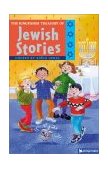
The Kingfisher Treasury of Jewish Stories
By Jane Cope
Ranging from folktales to contemporary stories, this anthology celebrates the richness of the Jewish heritage. The stellar list of contributors includes Isaac Bashevis Singer, Lynn Reid Banks, and Michael Rosen.
Description from Publisher

The 40 Greatest Jewish Stories Ever Told!
By Barbara Goldin, Peninnah Schram, Gloria Goldreich, and Rabbi Daniel and Chana Sperber
Includes:
- Ten Holiday Jewish Children's Stories
- Ten Classic Jewish Children's Stories
- Ten Traditional Jewish Children's Stories
- Ten Best Jewish Children's Stories
Stories from the Bible, the Talmud, Rabbinic Lore, and Jewish Tradition are included in this work. Each of the four books in the slipcase is fully illustrated. At the end of each of the 40 stories is a "Now Consider This" section designed to help the child and parent explore the moral message integrated into each tale.
The first collection of stories by professional Jewish storytellers. Each author has written a number of books and has a dedicated following. The individual volumes sell for $16.95 each, which means that the end purchaser gets one book free in the slipcase. The four volumes in the slipcase are each illustrated in color. There has been significant editing of the volumes in the sipcase which make the stories even more readable.
Description from Publisher

Hayyim's Ghost
By Eric A. Kimmel
A classic Jewish tale. Hayyim wakes up one morning only to find out that the entire town thinks he’s “gone to Heaven.” But he’s still here! With the help of the Rabbi, Hayyim sets out to find out what really happened. A humorous “Kimmelesque” story that children and adults will enjoy.
Description from Publisher
Page 1 |
Page 2 |
Page 3 |
Page 4 |
Page 5 |
Page 6 |
Page 7
Still can't find what you're looking for? Search Amazon.com's database directly.
©1999-2009
(NOTE: The following links have NOT been placed on the site by the website owners. We have no control over which ads are selected and are not responsible for their religious content.)
If this page came up without frames, Click here to see the complete website
Other Pages of Interest:
Jewish Folktales and Talmudic Stories for Children
(Page 1)
(Page 2)
(Page 3)
(Page 4)
(Page 5)
(Page 6)
(Page 7)
Easy Reader and Picture Books:
Jewish Children's Books (General) |
Jewish Board Books |
Biblical Stories for Children |
Jewish Holiday Books |
Jewish Family Cookbooks |
Jewish Folktales and Talmudic Stories for Children
(Page 1)
(Page 2)
(Page 3)
(Page 4)
(Page 5)
(Page 6)
(Page 7)
|
Jewish Life Books (Mitzvot, Keeping Kosher, etc.) |
Jewish Life Cycle Books |
Family Haggadahs |
Children's Prayerbooks |
Introductory Hebrew Books |
Jewish History and Historical Fiction Picture Books |
Israel Books
Middle School and YA Books:
Bar Mitzvah Books |
Jewish Fiction |
Historical Fiction |
Torah Study |
Prayer and Jewish Life Books |
Jewish Holidays |
Jewish Biographies |
Jewish History Books |
Holocaust Books for Teens |
Israel Books
Jewish Books for Children |
Bar Mitzvah Books |
Jewish Parenting Books |
Jewish Music for Children |
Jewish Videos |
Jewish Toys and Gifts |
Jewish Gift Baskets and Gourmet Food |
Jewish Jewelry |
Amazon.com Coupons, Promotions, and Sales
Other Pages of Interest:
Jewish Folktales and Talmudic Stories for Children
(Page 1)
(Page 2)
(Page 3)
(Page 4)
(Page 5)
(Page 6)
(Page 7)
Easy Reader and Picture Books:
Jewish Children's Books (General) |
Jewish Board Books |
Biblical Stories for Children |
Jewish Holiday Books |
Jewish Family Cookbooks |
Jewish Folktales and Talmudic Stories for Children
(Page 1)
(Page 2)
(Page 3)
(Page 4)
(Page 5)
(Page 6)
(Page 7)
|
Jewish Life Books (Mitzvot, Keeping Kosher, etc.) |
Jewish Life Cycle Books |
Family Haggadahs |
Children's Prayerbooks |
Introductory Hebrew Books |
Jewish History and Historical Fiction Picture Books |
Israel Books
Middle School and YA Books:
Bar Mitzvah Books |
Jewish Fiction |
Historical Fiction |
Torah Study |
Prayer and Jewish Life Books |
Jewish Holidays |
Jewish Biographies |
Jewish History Books |
Holocaust Books for Teens |
Israel Books
Jewish Books for Children |
Bar Mitzvah Books |
Jewish Parenting Books |
Jewish Music for Children |
Jewish Videos |
Jewish Toys and Gifts |
Jewish Gift Baskets and Gourmet Food |
Jewish Jewelry |
Amazon.com Coupons, Promotions, and Sales
Easy Reader and Picture Books:
Jewish Children's Books (General) | Jewish Board Books | Biblical Stories for Children | Jewish Holiday Books | Jewish Family Cookbooks | Jewish Folktales and Talmudic Stories for Children (Page 1) (Page 2) (Page 3) (Page 4) (Page 5) (Page 6) (Page 7) | Jewish Life Books (Mitzvot, Keeping Kosher, etc.) | Jewish Life Cycle Books | Family Haggadahs | Children's Prayerbooks | Introductory Hebrew Books | Jewish History and Historical Fiction Picture Books | Israel Books
Middle School and YA Books:
Bar Mitzvah Books | Jewish Fiction | Historical Fiction | Torah Study | Prayer and Jewish Life Books | Jewish Holidays | Jewish Biographies | Jewish History Books | Holocaust Books for Teens | Israel Books
Jewish Books for Children | Bar Mitzvah Books | Jewish Parenting Books | Jewish Music for Children | Jewish Videos | Jewish Toys and Gifts | Jewish Gift Baskets and Gourmet Food | Jewish Jewelry | Amazon.com Coupons, Promotions, and Sales
 Joseph Had a Little Overcoat By Simms Taback |
Awards:When Joseph's favorite overcoat gets old and worn, he makes a jacket out of it. When the jacket is more patches than jacket, Joseph turns it into a vest. When the vest's number is up, Joseph makes a scarf. This thrifty industry continues until there's nothing left of the original garment. But clever Joseph manages to make something out of nothing! (And that's the foreshadowed moral of the story.) In today's throwaway world, Joseph's old-fashioned frugality is a welcome change. Based on a Yiddish song from Simms Taback's youth (lyrics and music reproduced on the last page), the book is filled with rhythms and arresting colors that will delight every reader. As more and more holes appear in Joseph's coat, die-cut holes appear on the pages, hinting at each next manifestation. The illustrations are striking, created with gouache, watercolor, collage, pencil, and ink. Every inch of space is crammed with fanciful, funny details, such as the headline on a discarded newspaper: "Fiddler on Roof Falls off Roof." This Caldecott Award-winning book features playful illustrations and a witty text to retell the classic tale of a tailor who can always make something out of nothing. Joseph once had an overcoat which became old and worn, so he makes it into a jacket. When the jacket becomes work, Joseph turns it into a vest. This continues until he is left with only a button. When the button gets lost, Joseph can still manage to create something. Each page of the book features a cutout to help children visualize the overcoat becoming the new article of clothing. Adults will love the witty sayings scattered throughout the illustrations ("Fiddler on Roof Falls off Roof" in the newspaper and "Chad Gadya" on a bedroom poster). Adults and children alike will be enchanted by the detailed combination of drawings and photographs on each page. A superb choice for preschool and elementary school readers. | ||||||||||||||||||||||||||||||||||||||||||||
 It Could Always Be Worse : A Yiddish Folk Tale By Margot Zemach |
"Noise, arguing -- the close quarters problems of a large extended
family -- finally become too much for the 'poor, unfortunate' father. He
goes to the Rabbi, who advises him to bring the barnyard animals into the
one-room, overcrowded house -- with predictably hectic and hilarious
results . . . A natural for story hour."
Margot retells a classic Yiddish folktale in this charming picture book. A poor man lives in a small house with his wife, mother, and six children. Life is obviously quite chaotic for the residents of these close quarters. When the man complains to his Rabbi, he is told to bring the barnyard animals into the house one by one. Craziness ensues, until the Rabbi instructs the poor man to put all the animals back into the barn. After that, the family can savor the newfound peace and quiet. Hilarious watercolor paintings add to the increased craziness inside the small house. Children will delight in the narrative about the hectic nature inside the house. Awards: | ||||||||||||||||||||||||||||||||||||||||||||
 In God's Hands By Lawrence Kushner and Gary D. Schmidt |
When the sun sets and stars fill the sky, the square in the little town grows quiet and still. The cool air of distant hills mingles with the sweet scent of baking bread. The moon rises and glows softly. It’s the sort of place where miracles could happen.
David and Jacob live in the same little, ordinary town, but it’s almost as if they’re from different worlds. David is so poor he can barely feed his family. Jacob is so consumed with staying rich he thinks about nothing but money. But the two men have one thing in common: they both believe that miracles are big, magical things that can only happen somewhere else, to someone else. But when Jacob wakes up from a nap in synagogue one day, sure that God has demanded twelve loaves of bread from him, all this changes in amazing ways you’d never expect. A delightful, timeless legend based on Jewish tradition, In God’s Hands tells of the ordinary miracles that occur when we really, truly open our eyes to the world around us. This superb book demonstrates how God's miracles can often come about through people's actions. Jacob is a rich man who lives in the same town as poor David. Jacob falls asleep during the Torah reading one day, but wakes up just in time to hear the verse from Leviticus, "You shall bake twelve loaves of challah, and set them before Me in two rows, six in each row". Jacob assumes that God was speaking directly to him and, while he thinks the request is a bit unusual, who is he to question God's request? He promptly goes home and bakes twelve loaves of challah and places them in the synagogue's ark. Soon afterwards, David prays to God for some food to feed his family and then opens the ark. When he sees the twelve loaves of challah, he assumes that God has answered his prayers and takes the challah loaves home to his family. When Jacob sees that the challah loaves are all gone, he believes that God ate the challah and decides to continue making challah loaves each week. This continues for several years (Jacob bringing challah to the ark, David taking the challah home, neither man knowing that the other one is involved) until a wise Rabbi teaches the two men that their hands are God's hands. Kushner and Schmidt have created an excellent storybook to clearly demonstrate an important lesson, without being preachy. The narrative style is perfect for reading aloud. Baek's warm illustrations effectively evoke the character's varying emotions. An excellent choice for preschoolers and elementary-aged students. | ||||||||||||||||||||||||||||||||||||||||||||
 Something from Nothing By Phoebe Gilman |
In this lively adaptation of a folk tale, Gilman creates a close-knit Jewish
community in which nothing goes to waste. The wonderful baby blanket
Grandpa made for Joseph has begun to wear out. When Grandpa takes a
look at it, he finds "just enough material here to make . . ." something smaller.
First, he makes a jacket. When that wears out, he makes a vest, then a tie, and
so on. Finally, there is only enough fabric remaining to cover a button. When
Joseph loses his button, he is heartbroken until he realizes that there is "just
enough material here to make . . ." one more thing--a good story. Framed by
borders that look like wooden beams, busy street scenes and cutaway interiors
offer lots of old-world atmosphere. The borders also set off a complementary
picture story about a mouse family living beneath the floor of Grandpa's home.
Children will readily follow the tiny creatures' escapades and appreciate their
ingenuity in turning scraps from Joseph's blanket to their own advantage. The
red-gold tones of the background and the rich browns in the artwork lend a
feeling of warmth that perfectly replicates the flavor of the sweet, funny tale.
This delightful adaptation about a resourceful grandfather is based on a Yiddish folk tale. Joseph receives a blue blanket from his grandfather as a baby gift. After years of use, the blanket becomes worn and tattered. Instead of throwing the blanket out, Joseph gives it back to his grandfather, who transforms it into a jacket. When the jacket gets too small, his grandfather turns it into a vest. This continues over and over again, until Joseph's grandfather turns the fabric into a button. When Joseph accidentally loses the button, he wonders, how will he be able to create something from nothing. This charming tale features enough repetition that children will eagerly read along and try to predict what Joseph's grandfather will create next. The warm illustrations feature details of the activity in each room of Joseph's house. They even include the happenings of a mouse family that inherits whatever scraps are left after Joseph's grandfather has worked his magic. This storybook is sure to be a hit for reading aloud together. | ||||||||||||||||||||||||||||||||||||||||||||
 Something for Nothing By Ann Redisch Stampler |
In this Jewish folktale, a dog outsmarts three cats that harass and attempt to terrorize him when he moves into a new house in the country. Finally, Dog offers them gold in exchange for making as much noise as he heard in Bialystok. The cats eagerly accept his challenge, but after three nights they are left exhausted and greedier than ever. The dog asks that they come back and make more noise, even though he can no longer afford to pay them. Refusing to give him "something for nothing," the cats "never disturbed the peace and quiet of Dog's country cottage ever again." The bold, vibrant watercolors, many of them spreads and full-page illustrations with lots of pink, orange, green, and purple hues, are wonderfully evocative and detailed. In an author's note, Stampler explains that although she has found oral remembrances of this tale, she has not located other written versions. An appealing story that would make a fine read-aloud with lots of sound effects.
When Dog can no longer endure the clatter and clanging and rumbling and banging of the marketplace in Bialystok, he sets off for the country to find a quieter place to live. But on his first night in his new home, he is awakened by a gang of howling and yowling, hissing and screeching cats, who bombard his tidy cottage with apples and stones. So much for his newfound peace and quiet! But clever Dog comes up with a plan ... a very noisy plan. How he outwits his rowdy foes makes for a humorous, satisfying story, exuberantly illustrated with fantastical paintings reminiscent of the work of Marc Chagall. | ||||||||||||||||||||||||||||||||||||||||||||
 Raisel's Riddle By Erica Silverman |
A lovely re-imagining of the Cinderella story, with a fine twist. Raisel lives in a tiny village
in Poland with her grandfather, a poor scholar. When Zaydeh dies, Raisel goes to town to
seek work and finds it in the kitchen of a famed rabbi. But the cook mistreats her and
keeps her from the Purim party. That night, when Raisel gives her supper to an old woman,
the beggar grants her three wishes. Raisel, who then goes to the Purim party costumed as
Queen Esther and enchants the rabbi's son with her riddle, is wise enough to keep one wish
back and uses it for cleaning the kitchen when she returns at midnight. The next day the
rabbi's son searches for her, and Raisel, locked in the pantry, calls out her riddle: "What's
more precious than rubies, more lasting than gold? / What can never be traded, stolen, or
sold? / What comes with great effort and takes time, but then--/ Once yours, will serve you
again and again?" The rabbi's son knows the answer, which is "learning," and so they "lived
and learned happily ever after." The illustrations in velvety, muted colors make use of strong
geometric shapes and varying perspectives: we see Raisel and her Zaydeh through a window
studying together; the nasty cook looming over Raisel in the rabbi's kitchen; and dramatic
close-ups of Raisel and the beggar woman and a gorgeous one of Raisel dressed as Queen
Esther with the rabbi's son. This universal story fits into its Jewish milieu as neatly as a key in a lock.
Silverman tells of Raisel, an orphan girl who is raised by her scholarly grandfather until his death; three wishes from an old beggar woman allow Raisel to attend the Purim play dressed as Queen Esther, where she captures the attention of the rabbi's son. It is her clever riddle about the precious nature of learning, however, that eventually wins his heart. Carefully crafted, this story not only entertains, but it teaches readers about the Jewish holiday, Purim, Queen Esther, and the tradition of costumed re-enactment. Unlike a majority of the other versions of the Cinderella story, this one does not include a self-absorbed prince who combs the countryside looking for a bride of a particular shoe size; refreshingly, Silverman's hero is as intelligent as he is handsome, and seeks a bride who is his equal. Graber's illustrations are the perfectly complement, embodying Raisel's transformation from a life of servitude to one of riches ``more precious than rubies.'' | ||||||||||||||||||||||||||||||||||||||||||||
 One -Hundred-and-One Read-Aloud Jewish Stories By Barbara Diamond Goldin (Editor) |
Jewish tales, Bible stories, legends and historic accounts from every generation and every land come to life in this captivating collection of short selections designed to introduce pre-readers to the glories of Jewish storytelling.
Reading aloud is the very best way to introduce young children to new worlds, real and imaginary-and to the great pleasures found between the covers of books. This wide-ranging and engaging collection will introduce young and old alike to Biblical heroes, magical and mythical characters, kings, prophets, historic figures and real-life adventurers from Israel, America and many other lands. Selected and retold by well-known children's author Barbara Diamond Goldin, the stories are designed to be read in ten minutes or less, and the strength and richness of the narratives make them ideal at bedtime. From the stories of Moses, Solomon and Jonah to the legends of the Golem of Prague and the hapless inhabitants of Chelm, and including selections from such renowned writers as Sholom Aleichem and Isaac B. Singer, this is sure to become a treasured volume, read, reread, passed down and loved for years to come. | ||||||||||||||||||||||||||||||||||||||||||||
 Stories for Children By Isaac Bashevis Singer |
Thirty-six stories by the Nobel Prize winner, including some of his most
famous such as "Zlateh the Goat," "Mazel and Shlimazel," and "The Fools
of Chelm and the Stupid Carp."
In every tale, Singer's cautionary tone takes him from the grade school shelf and places him in the long line of moral fabulists from Aesop and La Fontaine to Kafka and Italo Calvino. All the time, it now appears, the rabbi's son has really been preaching to the adult in every boy and girl.
|
 A Thousand and One Chickens By Seymour Rossel
Join the adventures of the befuddled royal family of Chelm as they
seek the help of the kingdom's three silly sages. Jewish wisdom and
Jewish humor intertwine in this charming story for all ages
|
|
 The Adventures of Hershel of Ostropol By Eric A. Kimmel
Illustrated by Trina Schart Hyman. Kimmel retells ten stories about Hershel of Ostropol, a Jewish folk hero who lived during the first part of the nineteenth century. A man quick with a humorous saying or jest, Hershel lived by his wits, traveling from town to town in Eastern Europe. Readers may recognize Hershel from two of Kimmel's earlier books, Hershel and the Hanukkah Goblins . The latter - which is also the first story in this collection - tells how an empty-pocketed Hershel tricks a stingy innkeeper into feeding him "until his buttons burst." Money is a perennial problem for Hershel, and nothing pleases him more than acquiring it by outwitting rich, miserly folk. Stopping by the village tavern one afternoon, Hershel finds Count Potocki, who wagers one thousand rubles that Hershel can't tell a story so incredible that the count won't believe it. After many tall tales - including one about bees as big as wolves - all of which the count insists he believes, Hershel tells about meeting the count's mother in Hell, where she was sent for giving birth to "that rascal," the count. At that Count
Potocki roars that Hershel is a liar, and Hershel happily pockets the
money and leaves. Each story is illustrated by humorous
black-and-white drawings. --
|
|
 Journeys With Elijah : Eight Tales of the Prophet By Barbara Diamond Goldin
This gathering of retold stories from the Talmud and elsewhere features
dazzling watercolor art matched to encounters with the Old Testament
figure who has become, as Goldin
(While
the Candles Burn, etc.)
writes, "a symbol of hope, a figure who stands for what is just and
good in the world." She evokes the worldwide "journey" of the Jewish
people by setting her tales in an array of times and places, from
modern Israel to Argentina and ancient China; no matter where he
puts in an appearance, Elijah offers choices or chancy blessings
that, often indirectly, lead the perplexed, misled, or discontented
to wisdom. From tiny, jewel-like title decorations to crowd scenes
that ripple with movement, Pinkney's watercolors provide a
shimmering backdrop to these reverent, simply told renditions.
|
|

The Way Meat Loves Salt : A Cinderella Tale from the Jewish Tradition By Nina Jaffe
The Way Meat Loves Salt: A Cinderella Story from the Jewish Tradition
answers another perennial question that stems from both the Ten Commandments
and human nature: How much can a child love and honor a parent? "I love you as
much as diamonds," the oldest daughter answers her father. "I love you as
much as gold and silver," the second daughter answers. "I love you the way meat
loves salt," the third daughter, Mierleh, replies. Banished from her father's home
for this seemingly disrespectful declaration, Mireleh discovers her own path with
the help of Elijah the Prophet as fairy godmother. | This Yiddish story combines the stories of Cinderella and King Lear for a wonderful treat! When a rabbi asks his daughters how much they love him, his youngest daughter, Mireleh replies that she love him "the way meat loves salt." He interprets this as an insult and banishes her from his house. Once she reaches the countryside, Mireleh receives help from Elijah the Prophet, who gives her a magic stick that will grant her any wish and tells her to go to the home of a wealthy rabbi. Although the rabbi and his wife allow Mireleh to stay in their attic, they will not allow the beggar girl to join them at a wedding feast. When Mireleh uses her magic stick to conjure up a beautiful dress, she attends the wedding and the wealthy rabbi's son falls madly in love with her. At the feast for her own wedding, Mireleh asks that the food be prepared without any salt. At the feast, a rabbi complains that the food tastes horrible, and Mireleh reveals herself to her father who suddenly understands the love she had expressed so long ago. The oil paintings beautifully capture the flavor of an older time. Children will love the expressive narrative and the variation of the familiar Cinderella story. An excellent choice for reading aloud.
|  The Brothers' Promise By Frances Harber
In this traditional Jewish tale, a father dies and leaves his farm to his two sons,
who share the farm and look after each other, despite their very different lifestyles--
Yankle is a happily married family man, and Josef is a loner who spends his time
reading religious books. When a drought threatens the farm, the brothers independently
decide that the other needs whatever food has been saved. In a comic episode, the duo
go back and forth delivering food and wondering why they are each winding up with more
instead of less. Finally, they run into each other and, in a happy moment of realization,
remember their father's words: "When a brother helps a brother, the angels in heaven
weep tears of joy."
| In a poignant Talmudic tale of companionship, sharing, and respect, two farmer brothers make a promise to their dying father to help each other through life. If they do, their father tells them, ``the angels will weep with joy.'' Although the brothers are markedly differentmarried Yankel is a bon vivant who enjoys to fiddle and dance, while single Josef prefers to quietly read the holy books at nightthey get along, and are good-natured about their differences. When hard times hit the farm in the form of a dry spell, their loyalty is tested, and each brother sacrifices his own security to make sure the other has food. The brothers are provided for, courtesy of divine intervention, and the angels do weepit rains. Wickstrom's gentle characters bring the simple, lovely sentiment to life in a setting of rolling hills, illuminated by sunlight and candlelight.
|
 Golem By David Wisniewski
Awards:
| A monumental story of good and evil-and the gray areas in between-receives a dramatic presentation through Wisniewski's intricately cut colored-paper collage. The story takes place in sixteenth-century Prague, where Jews are being attacked mercilessly following the general acceptance of the "Blood Lie," a rumor that Jews are making their Passover bread from flour, water, and the blood of Christian children. To protect his people, Rabbi Loew decides to invoke the Golem, a giant made of clay. After creating the giant, the rabbi places the word emet , Golem is young and innocent, with a childlike ability to love and trust. The crisply cut colored-paper illustrations have been painstakingly created to show both small details and large landscapes. Some four hundred years ago (according to legend) a revered Jewish teacher and scholar, Rabbi Loew, shaped a giant man of clay called a "golem" and brought him to life. The golem's task was to vanquish those who persecuted the Jews of Prague, and he performed it almost too well. Retold from traditional sources and accompanied by masterly cutpaper illustrations, Golem is a dramatic tale of supernatural forces invoked to save an oppressed people. Golem offers a thought-provoking look at the consequences of unleashing power beyond human control -- even with the best of intentions. Both the text and the artwork demonstrate David Wisniewski's excellent storytelling talents.
|
 A Cloak for the Moon By Eric A. Kimmel
Based on a tale attributed to the 18th-century Rabbi Nachman of Bratslav, this luminously rendered story centers on a tailor named Haskel who lives in Tzafat (one of the four holy cities of Israel, long associated with Jewish mysticism). One night Haskel dreams that the moon comes to him, wishing for a cloak to keep herself warm, and Haskel vows to make her one. When he wakes up, he says, "Dream or not, I will keep my promise." Although his uncle, a master tailor, tells him to "stop chasing dreams," Haskel dedicates himself to his goal, and when he hears of a legendary garment that stretches or shrinks to fit the wearer, he sets out to find it, in a journey that takes him first to China and then across the desert to a city evocatively named The Roof of the World. Expertly pacing the story, Kimmel (previously paired with Krenina for The Magic Dreidels) embroiders his prose with graceful details, writing of "radiant satins [and] silks like colored water." The exotic trappings will lure readers, replacing Haskel's determination to keep his promise as the central theme of the work. Intermittently embellished by borders and spot art featuring delicate flower motifs, Krenina's gouache art effectively depicts the Middle and Far Eastern settings of the tale, as well as its timeless sensibility.
| Taken from the tales of Rabbi Nachman of Bratslav, this soulful story centers on a tailor, Haskel, who loves to watch the moon and one night dreams that the moon is cold. Vowing to make a cloak of shining material that will cover her as she waxes and wanes, Haskel sets out for China to look for the cloth. Finally, he tracks it to the "roof of the world" and finds a princess who cannot be wed because her wedding dress, made of beams of light, has unraveled. Using his tailor's tools, Haskel discovers that focusing moonlight on the dress with his magnifying glass enables the thread to reweave itself. The princess rejoices, and Haskel is given a bit of the luminous thread as reward. Each night of his return journey, he makes another cloth of light; when he gets home, his dream of a cloak for the moon is fulfilled. Gouache paintings and intricate borders that echo Chinese and Persian design have an exotic richness. Impossible dreams and magical desires fulfilled by dint of persistence and unwavering belief underlie this lovely narrative.
|
 Rachel Captures the Moon By Richard Ungar
The stories of the fabled village of Chelm and its inhabitants are favorites in Jewish folklore. Newcomer Richard Ungar captures the joyous spirit of these folktales in his words and pictures.
| The people of Chelm were crazy about the moon and the way it bathed the village in light. Not content to wait for the moon to rise, some of the villagers decide to capture it so they could see it whenever they wish. First the carpenter tries to reach it with a ladder. The next night the cook tries to entice the moon with soup. The musician, the weaver, and the fisherman all use their arts to try to lure the moon down to the village. To everyone’s surprise, young Rachel succeeds. But how does she capture the moon? Ungar makes an impressive debut in this reworking of a Samuel Tenenbaum story about the profoundly silly people of Chelm. Like Mole in Bringing Down the Moon, the inhabitants of the mythical village are so beguiled by the moon's "wondrous light" that they decide to capture it, "so we will all be able to gaze upon the moon at any time, day or night." Simon the Carpenter tries to build a ladder to it; Selma the Cook, Rafael the Musician and Sarah the Weaver try to tempt the moon down to earth with their respective talents. But only young Rachel is successful to the Chelmites' skewed way of thinking, at least when she captures the moon's reflection in a rain barrel. With dense, jewel-toned watercolors and colored-pencil illustrations, and characterizations and perspectives reminiscent of Chagall and other Jewish visual folklorists, Ungar swiftly and affectionately transports readers to a mythical, long-ago world.
|
 Rachel's Gift By Richard Ungar
As Passover approaches, Rachel's mother plans to make the best soup in the world to woo Elijah the Prophet and reap a rich reward. Using Bubbie's secret and not very helpful recipe, she begins to cook, and the aroma attracts many visitors with helpful hints of their own. In the end, it is Rachel's gift of kindness to an old man that brings a reward that is more than money. Although this tale lacks the outright silliness of many of the Chelm stories, the "lesson" is accompanied by lively action and smooth prose. The rich watercolor and colored-pencil illustrations in the style of folk art capture the European village setting, and the reds, yellows, and oranges add to the warmth of the tale. A welcome addition to Jewish folklore shelves.
| The author of Rachel Captures the Moon returns to Chelm with this story which combines The Magician with Stone Soup. It is Passover time, and Rachel's mother desperately wants Elijah the Prophet to visit and bestow good fortune on them. She receives a recipe from Bubbie from Bialystock and immediately concludes that she has found her lure. Unfortunately, the recipe is so vague that she must improvise based on what she has in the house. Various members of the community come in and each adds something to the soup to make it even more delicious. After Rachel shows kindness towards a poor visitor, everyone notices that some of the wine in Elijah's cup has disappeared. Rachel's act of generosity was able to teach the adults an important lesson. Ungar's rich Chagall-like watercolors bring a dreamlike quality to the story that will draw children into the story. An excellent addition to a folklore or Passover holiday collection.
|
 Rachel's Library By Richard Ungar
The citizens of Chelm have always had a reputation for foolishness. How can they convince people otherwise and show outsiders their true wisdom? Surely the answer lies in the great city of Warsaw. They will send a delegation to the capital to find a solution.
| Young Rachel is an unexpected addition to the group, but as always, she is the one with the answer. The clue to wisdom lies in books. What Chelm needs is a library. In her own creative fashion, Rachel finds a way to build a village library – different from any library you can imagine. Rachel Captures the Moon and Rachel’s Gift have introduced the endearing village of Chelm – always quirky and always full of surprises. Ungar's third story about Rachel, "inspired by" Samuel Tenenbaum's"Chelm's School," finds the clever child traveling to the city of Warsaw with a small delegation of fellow residents who are hoping to find a way to show others that the people of Chelm are wiser than they seem. Rachel's idea to create a library is eagerly accepted, and the townsfolk immediately pool their resources to construct one that, despite its unorthodox design, is both extraordinary and useful to every household. The attractive folk-art illustrations, created with watercolor and thickly applied colored pencil that gives the appearance of oil pastel, are jewel-toned, with heavy use of red, fuchsia, and emerald. They show people in peasant dress, simple cottages, the dirt roads of the shtetl (small 19th-century Eastern European village), and the crowded streets of Warsaw. The humor in this story rooted in Jewish folk literature can be appreciated by children of various backgrounds.
|
 The Boy Who Stuck Out His Tongue : A Yiddish Folk Tale By Edith Tarbescu
The widow's son is a naughty boy. When he is asked to help in the house,
he sticks out his tongue and continues throwing snowballs. His mother
retaliates by chasing him. This causes a fall against a wrought-iron
fence. Now the boy's tongue is stuck to the cold metal. What can the
mother do? She goes to the cobbler, the butcher, and the baker. No one
knows what to do about a frozen tongue. Finally, the foolish townspeople
decide to build a hut around the boy to keep him warm until they find a
way to free him. This lighthearted Hungarian story will appeal to young
readers. The boy's predicament is something that still happens to
children in cold weather, particularly on the playground, making this
a good winter tale for the classroom. The illustrations are full of
snowflakes and colorful winter clothing. Each page is bordered with a
brightly patterned, fringed scarf. The story comes from the oral
tradition; the book flap says Tarbescu heard this tale from her
Hungarian father. Yiddish humor, Chelm-like characters, and a tidy
moral inhabit the story without overwhelming it. The story's strongest
feature is the plot, and readers will stay tuned to find out how the
boy's tongue is finally freed.
|
|
 You Never Know : A Legend of the Lamed-Vavniks By Francine Prose
While this legend is of Jewish origin, the ideals of righteousness
and equality among human beings (wealthy and poor, learned and
simple) are inherent in many religious and cultural teachings
throughout the world. Poor Schmuel, the town cobbler of Plotchnik,
has a reputation for doing stupid things, which are actually acts
of kindness. When a drought threatens the town, he alone is able
to communicate with God, first bringing rain and then making the
rain cease. The Rabbi eventually realizes that Schmuel is a
Lamed-vavnik, one of the 36 righteous individuals living in the
world who do good deeds. As the legend goes, once their existence
is discovered, they disappear. And so it is with Schmuel.
| Prose, who cites several sources, uses the simple style of the storyteller to tell this tale, which makes it an excellent read-aloud. By successfully avoiding a heavy-handed lesson, she allows children to discover the meaning for themselves. Podwal uses gouache and colored pencils to create both the smeary look of oils and the flatness of tempera. His abstract paintings are done primarily in earthy tones of brown and sky blue, and the pictures are filled with representations of Jewish symbols. Despite these images, however, this accessible tale has universal appeal and will provide enjoyment as well as food for discussion. Stories involving secret identities are greatly appealing to children, and Francine Prose has written a lovely tale around this intriguing legend.
|  Bit by Bit By Steve Sanfield
Based on a Yiddish song that Sanfield's grandmother brought with her from
Russia, this is a kind of cumulative story, told with a joyful rhythm and
repetition, and illustrated with bright, clear, large figures that make it great
for group sharing. Zundel the tailor makes himself a coat that he loves:
"He wore it in the morning and he wore it at night. He wore it and wore
it and wore it until bit by bit he / w-o-r-e / it / out." Heartbroken, he
makes what's left of the coat into a jacket, and he loves that even more,
but the jacket wears out. Then he makes a vest, a cap, a pocket, a button,
each one more beloved than the last. The pictures extend the song, showing
the tailor with his loving family through the years, as each piece of clothing
wears out, but his bonds stay strong. The book begins and ends with the
storyteller, which makes clear that the coat does live on as long as the
story is told.
| Zundel the tailor loves the fabric of his coat so much that he transforms it into a jacket, then a vest, then a cap, and so on, as each successive garment wears out. The exuberant illustrations show Zundel interacting with his growing family. Related by a storytelling narrator, the circular tale is ideal for reading aloud.
|
 Just Stay Put: A Chelm Story By Gary Clement
This enjoyable tale tells another tale from the silly town of Chelm. Mendel dreams of travelling, so one day, he decides to head off for Warsaw. When he decides to rest for a bit, he worries that he will forget the way to Warshaw, so he takes off his boots and points them in the direction of Warshaw. After a shepherd moves his shoes, Mendel takes off in the direction his shoes are now pointing: towards Chelm! When he arrives back in Chelm, he is convinced that he is actually in Warsaw. From Mendel's viewpoint, Warshaw looks very familar and surprisingly has a house just like his and a woman inside who very closely resembles his wife. After much deliberation, Mendel decides that since Warsaw and home are so much the same, he may as well just stay put. Gary Clement's pen and ink drawings perfectly balance Mendel's quirky logic. Children will delight in the continuing antics of the residents of Chelm. A perfect choice for reading aloud.
|
|
 A Journey to Paradise and Other Jewish Tales By Howard Schwartz
These eight magical tales reflect on the aspirations, mores, problems,
and humor of the Jewish people. Drawn from the Israel Folktale Archives,
the selections come from Eastern Europe, Tunisia, Israel, and Yemen.
"The Flight of the Midwife" demonstrates that in Yemen, the midwife
was noted for her courage, wisdom, and impartiality, even to the extent
of attending to the birth of a female demon in the form of a cat. "A
Student in Magic" has a familiar theme: that one need not travel far
to seek the "prize," as it is usually nearby. The title story
demonstrates the veneration held by Hasidic followers for their rabbis,
even attributing magic powers to them. "An Apple from the Tree of Life"
relates how the Jews strove to please a ruler so that he would leave
them in peace. In "A Messenger from the World to Come," a poor trickster
uses the gullibility of the Chelmites to obtain clothing for his family
by saying that he is from "The World to Come" and that their deceased
loved ones haverequested warm winter clothing. Schwartz is a master
storyteller and Carmi is a proven illustrator, guaranteeing that this
book will be a popular choice for a wide audience.
|
|
 Next Year in Jerusalem : 3000 Years of Jewish Stories By Howard Schwartz
Schwartz, an accomplished folklorist, has collected Jewish folktales,
midrashim, and legends with ties to Jerusalem and presents them here in
a handsomely illustrated book. He begins with a brief history of the
city, both its actual history and the one of legend, from which these
stories come. The tales, which originated in places like Iraq,
Eastern Europe, Spain, and, of course, Israel, cover a wide range. There's
the legend of Serah bat Asher, who lived hundreds of years after being
blessed by Jacob when she told him his son Joseph was alive; there
are tales of King David and his son Solomon, stories of peace,
generosity, and God's love. Sidebars set the tales in a factual
framework, and all are lovingly illustrated by Waldman in a dreamy
style colored with the golds, pinks, and blues that shine from the
real city of Jerusalem.
|
|
 Invisible Kingdoms: Jewish Tales of Angels, Spirits, and Demons By Howard Schwartz
Come to a world where angels, ghosts, and demons walk amongst the living and anything is possible. Here, in nine tales of the supernatural, invisible creatures take shape and roam the earth to aid or interfere in the lives of humans. A magic staff makes a man see ghosts, a handsome demon tricks a village girl into marriage, and an angel directs a young man through a dangerous venture -- in the guise of a goat!
| Howard Schwartz's vibrant retelling of mystical Jewish folktales id full of magic and wonder. The stories span many centuries and range in origin from Middle East to Eastern Europe. Weather you believe in angels, ghosts, and demons os for you to decide, but not before you enter these invisible kingdoms and step into a world where the impossible takes shape and anything can happen!
|
 Elijah's Violin & Other Jewish Fairy Tales By Howard Schwartz
In Elijah's Violin, Howard Schwartz presents a sumptuous collection
of 36 Jewish fairy tales from virtually every corner of the world. These stories
will captivate children and adults alike as they illuminate the Jewish world view,
where faith in God can defeat the evil impulse. "Timeless truth."--Jewish Journal.
|
|
 My Grandmother's Stories: A Collection of Jewish Folk Tales By Adele Geras
More than 30 pages of full-color illustrations bring a Chagall-esque quality to the beautiful compliation of Jewish stories. Readers will be enchanted by each tale as the Grandmother recounts her days as a young girl, cooking and hanging laundry as she plans for the Sabbath, and preparing for the Passover meal. The details of each story emphasize the Jewish traditions and customes that continue in many families today. My Grandmother's Stories is truly the ideal gift for the Jewish holidays -- the lively folk tales and gorgeous illustrations have created an instant classic.
| Readers can almost smell the strudel Grandma makes in these lovingly evoked, beautifully framed Eastern European Jewish folktales. Each of 10 chapters describes a child's visit to Grandma's, during which a simple act--trying on an aunt's high-heeled shoes, dressing up in a lace tablecloth--inspires a not-so-simple tale. Geras's (Voyage; Nursery School Rabbit ) Grandma is a gifted raconteur; her repertoire includes some familiar stories (a rabbi instructs a couple complaining of cramped quarters to bring their animals into the house) and some familiar characters (the "wise men" of Chelm), as well as the more novel (a "market of miseries," a ghost-bride). What gives these retellings a special patina is the long-ago-and-far-away quality of the child's visits themselves, set in an undisclosed time and place. Story elements specific to Judaism are explained without fanfare; even the word "rabbi" is unobtrusively defined. And the intricacy of Jordan's pen-and-ink and color illustrations articulates the wealth of detail suggested by the text. This wise and warmhearted collection of 10 Jewish tales originally published in 1990 (Knopf; o.p.) has been illustrated with full-color paintings. Each of the stories is introduced in the broader framework of a little girl exploring her grandmother's apartment. Individual rooms or objects spark the child's interest and each time her grandmother says, "It reminds me of a story." All of her tales impart universal truths about everyday foibles and follies, always in the gentle voice of a loving bubbe who sometimes passes on age-old Jewish observances and customs in the process. The stories are set in Jerusalem, in Chelm with its fools, and in small towns with wise rabbis and even wiser wives. In the loveliest selection of all, a dove must select the very best plant in a garden. Her choice is the olive tree because it is nourishing, modest, kind, and "a symbol of peace in the world." Lobel's energetic and robust paintings provide the perfect accompaniment. These are stories to be shared and treasured.
|
 The Kingfisher Treasury of Jewish Stories By Jane Cope
Ranging from folktales to contemporary stories, this anthology celebrates the richness of the Jewish heritage. The stellar list of contributors includes Isaac Bashevis Singer, Lynn Reid Banks, and Michael Rosen.
|
|  The 40 Greatest Jewish Stories Ever Told! By Barbara Goldin, Peninnah Schram, Gloria Goldreich, and Rabbi Daniel and Chana Sperber
Includes:
|
The first collection of stories by professional Jewish storytellers. Each author has written a number of books and has a dedicated following. The individual volumes sell for $16.95 each, which means that the end purchaser gets one book free in the slipcase. The four volumes in the slipcase are each illustrated in color. There has been significant editing of the volumes in the sipcase which make the stories even more readable.
|
 Hayyim's Ghost By Eric A. Kimmel
A classic Jewish tale. Hayyim wakes up one morning only to find out that the entire town thinks he’s “gone to Heaven.” But he’s still here! With the help of the Rabbi, Hayyim sets out to find out what really happened. A humorous “Kimmelesque” story that children and adults will enjoy.
| |